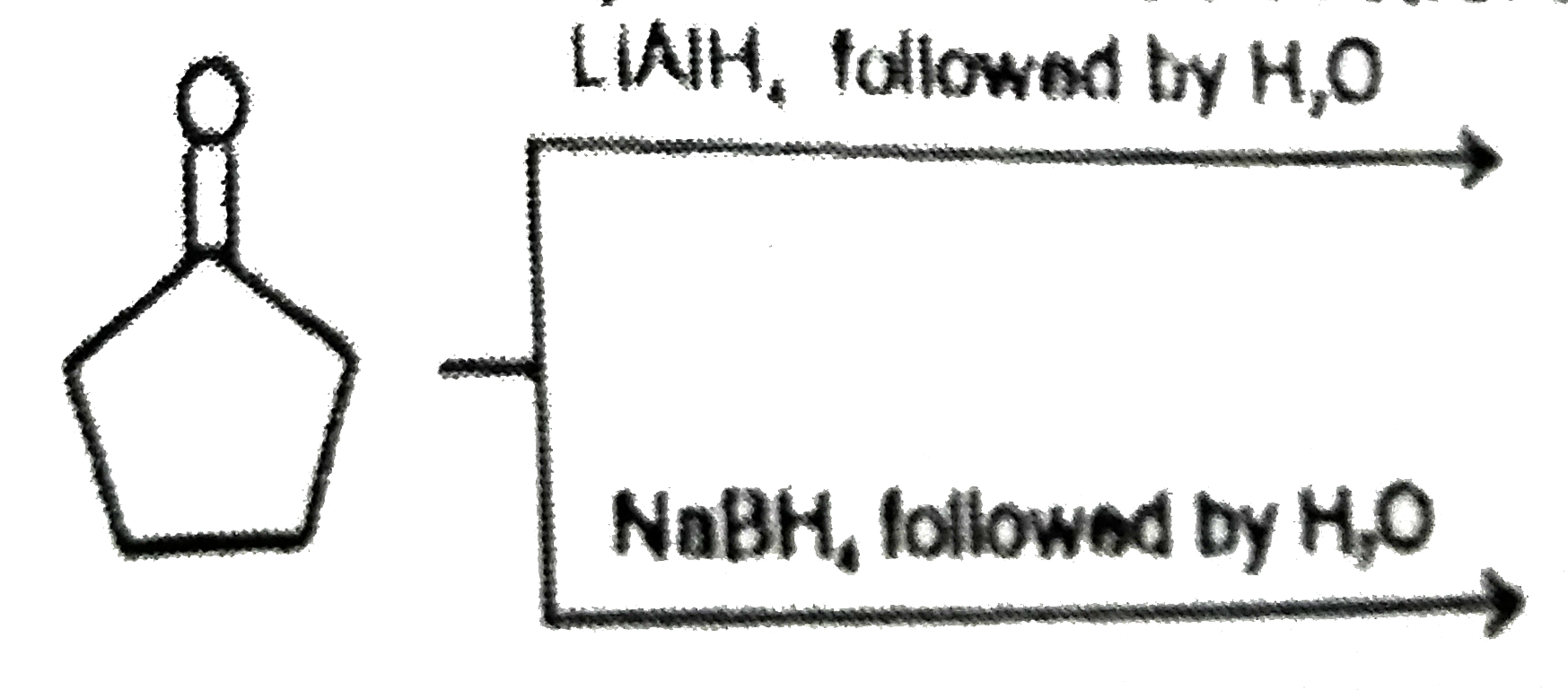Assume each reaction is carried in open container. For which
reaction ΔH>ΔE?
H2(g)+I2(g)→2HI(g)
N2(g)+3H2(g)→2NH3(g)
PCl5(g)→PCl3(g)+Cl2(g)
SO2(g)+12O2(g)→SO3(g)
The correct Answer is:C
To determine for which reaction the change in enthalpy (ΔH) is greater than the change in internal energy (ΔE) when the reactions are carried out in an open container, we can use the relationship between ΔH and ΔE:
1. Understand the relationship between ΔH and ΔE:
The relationship is given by the equation:
ΔH=ΔE+ΔNGRT
where ΔN_G is the change in the number of moles of gas, R is the universal gas constant, and T is the temperature in Kelvin.
2. Identify the condition for ΔH > ΔE:
Rearranging the equation, we find:
ΔH−ΔE=ΔNGRT
For ΔH to be greater than ΔE, the term ΔN_G must be greater than 0:
ΔNG>0
3. Define ΔN_G:
ΔN_G is defined as the difference between the moles of gaseous products and the moles of gaseous reactants:
ΔNG=(moles of gaseous products)−(moles of gaseous reactants)
4. Analyze the reactions:
For each reaction, calculate ΔN_G:
- Reaction 1: If the reaction has 2 moles of gas products and 1 mole of gas reactants:
ΔNG=2−1=1(ΔN_G > 0)
- Reaction 2: If the reaction has 2 moles of gas products and 3 moles of gas reactants:
ΔNG=2−3=−1(ΔN_G < 0)
- Reaction 3: If the reaction has 2 moles of gas products and 1 mole of gas reactants:
ΔNG=2−1=1(ΔN_G > 0)
- Reaction 4: If the reaction has 1 mole of gas products and 1 mole of gas reactants:
ΔNG=1−1=0(ΔN_G = 0)
5. Conclusion:
From the analysis, we find that ΔN_G is greater than 0 for certain reactions. Therefore, for those reactions where ΔN_G > 0, we can conclude that ΔH > ΔE.
The relationship is given by the equation:
ΔH=ΔE+ΔNGRT
where ΔN_G is the change in the number of moles of gas, R is the universal gas constant, and T is the temperature in Kelvin.
Rearranging the equation, we find:
ΔH−ΔE=ΔNGRT
For ΔH to be greater than ΔE, the term ΔN_G must be greater than 0:
ΔNG>0
ΔN_G is defined as the difference between the moles of gaseous products and the moles of gaseous reactants:
ΔNG=(moles of gaseous products)−(moles of gaseous reactants)
For each reaction, calculate ΔN_G:
- Reaction 1: If the reaction has 2 moles of gas products and 1 mole of gas reactants:
ΔNG=2−1=1(ΔN_G > 0)
- Reaction 2: If the reaction has 2 moles of gas products and 3 moles of gas reactants:
ΔNG=2−3=−1(ΔN_G < 0)
- Reaction 3: If the reaction has 2 moles of gas products and 1 mole of gas reactants:
ΔNG=2−1=1(ΔN_G > 0)
- Reaction 4: If the reaction has 1 mole of gas products and 1 mole of gas reactants:
ΔNG=1−1=0(ΔN_G = 0)
From the analysis, we find that ΔN_G is greater than 0 for certain reactions. Therefore, for those reactions where ΔN_G > 0, we can conclude that ΔH > ΔE.
Topper's Solved these Questions
- BOOK - ALLENCHAPTER - CHEMISTRY AT A GLANCEEXERCISE - INORGANIC CHEMISTRY300videos
CHEMISTRY AT A GLANCE
- BOOK - ALLENCHAPTER - CHEMISTRY AT A GLANCEEXERCISE - ORGANIC CHEMISTRY472videos
CHEMISTRY AT A GLANCE
- BOOK - ALLENCHAPTER - Chemical EquilibriumEXERCISE - All Questions30videos
Chemical Equilibrium
- BOOK - ALLENCHAPTER - ELECTROCHEMISTRYEXERCISE - EXERCISE -05 [B]38videos
ELECTROCHEMISTRY
Similar Questions
Knowledge Check
- Question 1 - Select One
Which reaction is termed as Darzen's reaction ?
AROH + HCIBROH+PCI5CROH+SOCl2DROH+PCl3
Which reaction is not an example of nucleophilic addition reaction?
View SolutionCalculate the work done when 112 g iron reacts with dilute HCl at 300 K. The reaction is carried out in an open container
(At mass of Fe = 56)View SolutionThe enthalpy of reaction is maximum in which of the following reaction?
View SolutionRate of a reaction increases by 106 times when a reaction is carried out in presence of enzyme catalyst at same temperature. Determine change in activation energy.
View SolutionIn which reaction will an increase in the volume of the container favor the formation of products?
View SolutionWhat is the product of each reaction
 View Solution
View SolutionWhich of the following reactions are disproportionation reaction ?
View Solution

